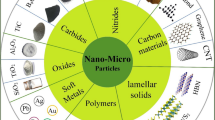Abstract
Pure and composite nickel deposits containing nano-TiO2 particles (d m = 21 nm) were produced under direct-DC and pulse current-PC conditions. The influence of pulse frequency on the codeposition of TiO2 particles, preferred orientation of Ni crystallites and grain size, as well as microhardness of the composites, was investigated systematically. Composites prepared in PC regime displayed higher incorporation percentage than those obtained under DC conditions, and the highest incorporation rates were achieved at pulse frequencies ν > 100 Hz. The application of pulse frequency accompanied by the embedding of TiO2 nanoparticles in the nickel matrix resulted in a strong influence upon the crystalline orientation, the grain size and the corresponding microhardness. All composites exhibited higher microhardness values compared to the pure deposits, independent of the applied current conditions. Overall, when ascribing the observed strengthening effect of composites, not only grain refinement and dispersion strengthening mechanisms but also preferred crystalline orientation should be taken into consideration.









Similar content being viewed by others
References
Viswanathan V, Laha T, Balani K, Agarwal A, Seal S (2006) Mater Sci Eng R 54:121
Ui K, Fujita T, Koura N, Yamaguchi F (2006) J Electrochem Soc 153:C449
De Tacconi NR, Carmona J, Rajeshwar K (2000) Langmuir 16:5665
Deguchi T, Imai K, Matsui H, Iwasaki M, Tada H, Ito S (2001) J Mater Sci 36:4723
Praveen BM, Venkatesha TV (2008) Appl Surf Sci 254:2418
Li J, Sun Y, Sun X, Qiao J (2005) Surf Coat Technol 192:331
Lin CS, Lee CY, Chang CF, Chang CH (2006) Surf Coat Technol 200:3690
Lampke Th, Leopold A, Dietrich D, Alisch G, Wielage B (2006) Surf Coat Technol 201:3510
Sun XJ, Li JG (2007) Tribol Lett 28:223
Abdel-Aal A (2008) Mater Sci Eng A 474:181
Thiemig D, Bund A (2008) Surf Coat Technol 202:2976
Wielage B, Lampke Th, Zacher M, Dietrich D (2008) Key Eng Mater 384:283
Abdel-Aal A, Hassan HB (2009) J Alloys Compd 477:652
Spanou S, Pavlatou EA, Spyrellis N (2009) Electrochim Acta 54:2547
Lampke Th, Wielage B, Dietrich D, Leopold A (2006) Appl Surf Sci 253:2399
Ibl N, Puippe JC, Angerer H (1978) Surf Technol 6:287
Kollia C, Spyrellis N, Amblard J, Froment M, Froment M, Maurin G (1990) J Appl Electrochem 20:1025
Choo RTC, Toguri JM, El-Sherik AM, Erb U (1995) J Appl Electrochem 25:384
Gyftou P, Pavlatou EA, Spyrellis N (2008) Appl Surf Sci 254:5910
Zimmerman AF, Clark DG, Aust KT, Erb U (2002) Mater Lett 52:85
Qu NS, Chan KC, Zhu D (2004) Scripta Mater 50:1131
Chen L, Wang L, Zeng Z, Xu T (2006) Surf Coat Technol 201:599
Wang W, Hou FY, Wang H, Guo HT (2005) Scripta Mater 53:613
Stroumbouli M, Gyftou P, Pavlatou EA, Spyrellis N (2005) Surf Coat Technol 195:325
Wang L, Gao Y, Xue Q, Liu H, Xu T (2005) Mater Sci Eng A 390:313
Pavlatou EA, Stroumbouli M, Gyftou P, Spyrellis N (2006) J Appl Electrochem 36:385
Kollia C, Patta C, Vassiliou P, Kasselouri V (2003) “CTM 2003”, 5–7 November 2003, Madrid, pp 417–428
Yang X, Li Q, Hu J, Zhong X, Zhang S (2009) J Appl Electrochem 40:39
Pavlatou EA, Raptakis M, Spyrellis N (2007) Surf Coat Technol 201:4571
Zanella C, Lekka M, Bonora PL (2009) J Appl Electrochem 39:31
Celis JP, Roos JR, Vooren WV, Vanhumbeeck J (1987) Oberflaeche Surf 6:16
Bahrololoom ME, Sani R (2005) Surf Coat Technol 192:154
Podlaha EJ, Landolt D (1997) J Electrochem Soc 144:L200
Celis JP, Roos JR, Buelens C (1987) J Electrochem Soc 134:1402
Celis JP, Roos JR (1977) J Electrochem Soc 124:1508
Tantavichet N, Pritzker M (2005) Electrochim Acta 50:1849
Amblard J, Froment M, Spyrellis N (1977) Surf Technol 5:205
Low CTJ, Wills RGA, Walsh FC (2006) Surf Coat Technol 201:371
Fritz T, Griepentrog M, Mokwa W, Schnakenberg U (2003) Electrochim Acta 48:3029
Hou F, Wang W, Guo H (2006) Appl Surf Sci 252:3812
Acknowledgements
The authors would like to dedicate this study to the memory of Professor Nicolas Spyrellis, who has greatly inspired them during this study. This paper is part of the 03ED963/2003 research project, implemented within the framework of the “Reinforcement Programme of Human Research Manpower” (PENED) and co-financed by National and Community Funds (20% from the Greek Ministry of Development-General Secretariat of Research and Technology and 80% from E.U.-European Social Fund).
Author information
Authors and Affiliations
Corresponding author
Rights and permissions
About this article
Cite this article
Spanou, S., Pavlatou, E.A. Pulse electrodeposition of Ni/nano-TiO2 composites: effect of pulse frequency on deposits properties. J Appl Electrochem 40, 1325–1336 (2010). https://doi.org/10.1007/s10800-010-0080-3
Received:
Accepted:
Published:
Issue Date:
DOI: https://doi.org/10.1007/s10800-010-0080-3




